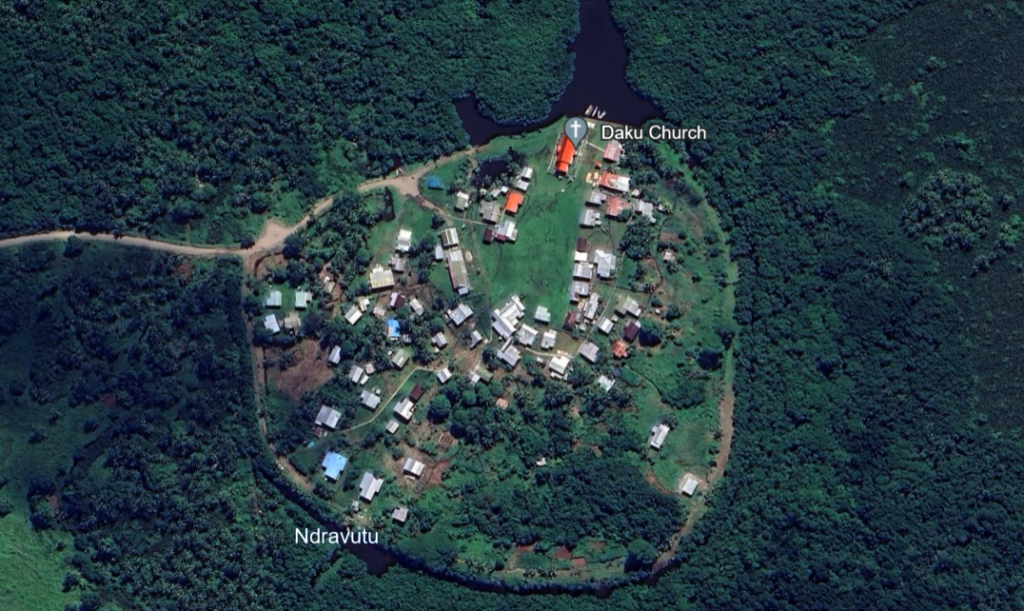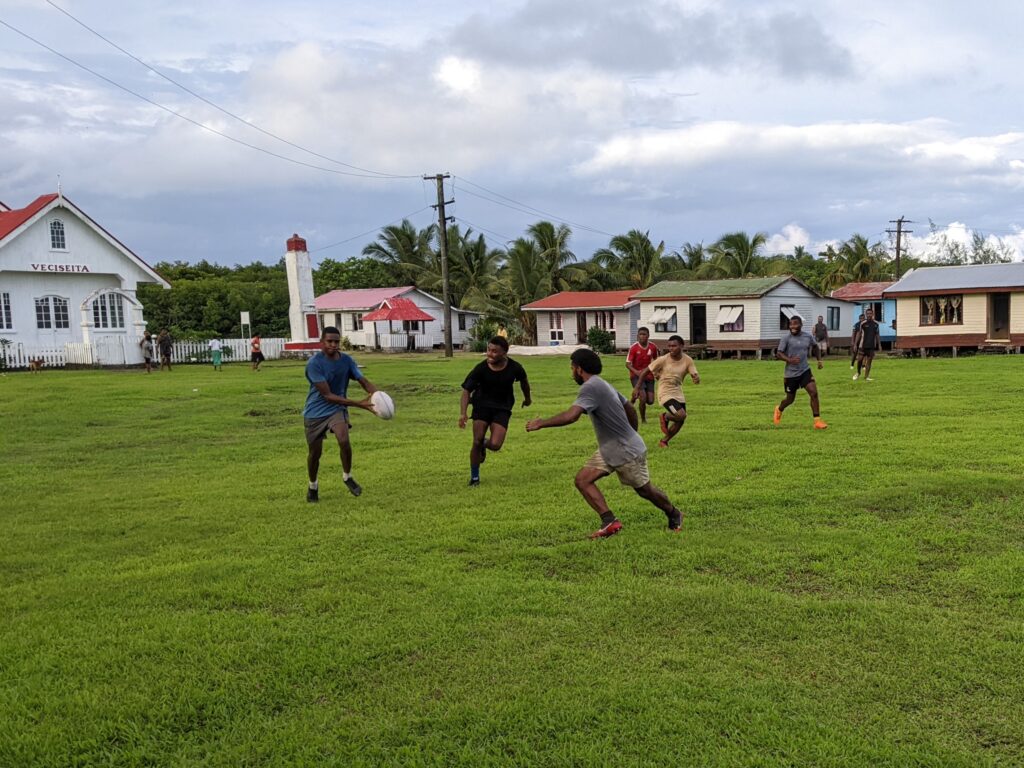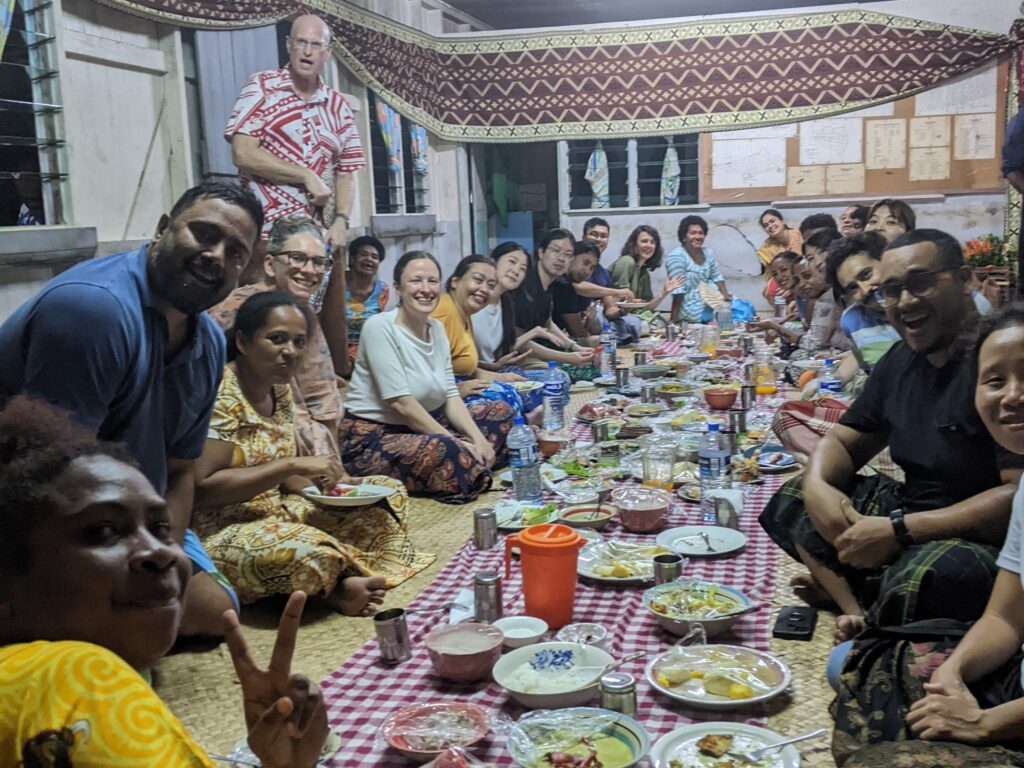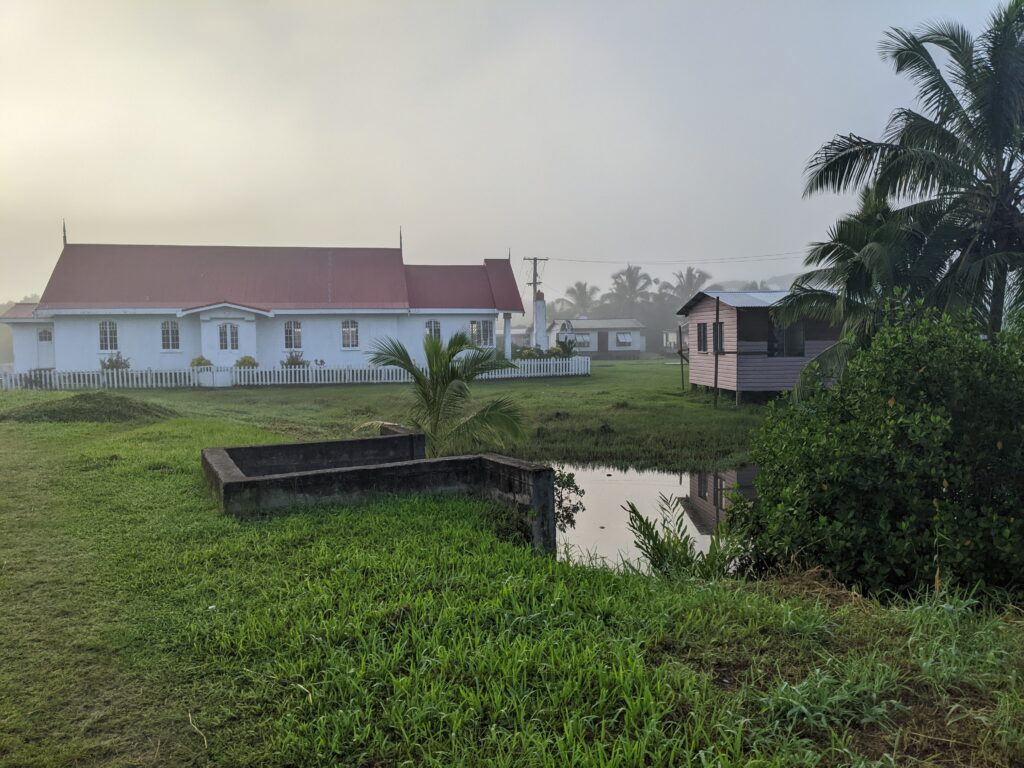<– Start at the beginning of the Climate Lab series
Fiji, Part 2 – In the Field
The Fijian word “vanua” loosely translates to “land,” but it means much, much more. It refers to the natural environment, social bonds and kinship ties, ways of being, spirituality, and stewardship. Where you were born is part of who you are – to the extent that your umbilical cord is buried near your home after your birth, and your body is buried under the foundation of your house after your death. There is an inherent connection to place, to the extent that it is part of your identity – and for people who have lost their homes, their land, their vanua, the situation is likened to a soul without a body.

Image credit: [1]
This background is critical for understanding why conversations about relocation in the face of climate change are so fraught. Fiji is experiencing rising sea levels and more intense storms, and its coastal communities (of which there are many) feel impacts such as flooding and storm damage more strongly and more frequently. These changes make life and livelihood increasingly more difficult to navigate, but there are people who would rather die than leave their homes. And for that reason, the concept of relocation is generally a non-starter. In the villages we visited, the focus remains on adaptation and what can be done to ensure that people can remain connected to their vanua in the face of an existential threat.
“Bula Vinaka”
Daku Village is located near the east coast of Fiji’s largest island, Viti Levu, about an hour’s drive northeast of Fiji’s capital, Suva. Construction of the village began in 1937, which involved taking coral from the reef (several of us cringed upon hearing that) to raise and stabilize the land. A dyke with five flood gates surrounds the village, protecting its 260-some residents. Unfortunately, four of the flood gates are not working properly, and the village floods at least monthly, forcing residents to wade through ankle-deep water, even on the raised cement walkways now built between homes, the community hall, and the school.
Fiji presided over the United Nations Climate Change Conference in Germany in 2017 (COP 23, [2]), and representatives from Daku attended to plead for support, showing videos of the regular flooding they experience and how climate change is making the situation worse over time. Not just an inconvenience, poor drainage leads to stagnant water in the village, increasing the risk of mosquito-borne diseases; meanwhile, salt water in farming areas affects the size and taste of their produce, mainly coconuts. A primary adaptation goal in this village is to rebuild their four nonfunctional flood gates (to match the one built with funds from USAID) and to raise their sea wall.

The second week of October every year is a time for Daku to raise awareness of – and money for – their climate change adaptation efforts. The village has set up its own support fund because they feel they can’t continue to simply wait for help. We were told that it is difficult to get sufficient money from the government or international aid organizations because the work to adapt is so expensive. I didn’t get the chance to ask (nor was I sure if I should) whether adaptation is more expensive than relocation, but a representative from the Ministry of Environment and Climate Change had told us on Monday that it costs $5M Fijian to relocate one community. As we listened to leaders from the village explain their adaptation plan, I wondered how long adaptation measures – with higher sea walls and additional flood gates – would be possible before relocation became necessary. But I already knew that relocation wasn’t an option in their minds.
Fijian Family
The people of the village have welcomed researchers, students, and other visitors before, but to our knowledge, ours was the first or largest group that had ever stayed overnight. After introductions and a formal welcome in the community hall, the chief declared that we were all now “from Daku.” About 10 families opened their homes to our group, and we went in pairs to meet our new Fijian moms and dads. My classmate Raksha and I stayed in the chief’s home, where three generations of family live in two bedrooms, a sitting room, and a kitchen. Our new Fijian sister, the chief’s daughter-in-law, acquainted us with their house, their village, and some of their traditions.
We learned that Fijian villages are similarly organized in hierarchy, with different families playing different roles (e.g. fishermen, craftsmen, warriors, clergy, etc.), and that your work is determined for you based on the family into which you are born – at least for the men. While all young people have a claim to the land in their home village before marriage, when women get married, they move to their husband’s village and relinquish their claims back home, becoming part of the husband’s family and joining that family’s role within his village. Our sister met her husband at school, not knowing he was a chief’s son, but when she married him, she became part of Daku and its leadership.

Fijian villages also tend to be organized similarly in physical layout, with the (Methodist) church and community hall located prominently, the elementary school easily accessible, and homes possibly organized based on the role of the family within the social structure. But despite the traditional roles governing certain protocols (which we would learn), my American eyes saw far less hierarchy and separation than they’re used to back home. As we walked around the village, we saw groups of kids playing together, running in and out of the open doors of each other’s houses. The sense of “ours” (as opposed to “yours vs. mine”) was immediately and overwhelmingly apparent.
What’s Said and Unsaid
Making our way back to the community hall that afternoon, leaders invited us to sit with them for a slide presentation about their experiences and efforts over the years, including the video they showed at COP 23. As the slide deck wrapped up and the projector shut down, we got the chance to ask questions and share stories ourselves. Storytelling is a significant part of culture in many islands across the Pacific. I first encountered the concept during our time in Hawai’i in the form of “talk story,” which served to acquaint our cohort with the history, experiences, and perspectives of those we met. In Fiji, “talanoa” can serve the same purpose, frequently with a more formal component of problem-solving. Talanoa sessions can take place over long stretches of time in the afternoon or evening, often with the men of the community taking the lead in discussing the issues of the day. And aiding these conversations is kava.
Kava is a drink made from the dried and pounded roots of the kava plant and mixed with water in a ceremonial bowl called a “tanoa.” It is a revered drink, used for welcoming visitors and facilitating conversation, but it is increasingly being used (in and outside of the Pacific islands) solely for its depressant properties. Kava is non-alcoholic, but the active compounds can produce muscle relaxation and a slight sense of euphoria, and it is considered to have an “acceptably low level of health risk” in moderation, according to the World Health Organization. [3] Almost everyone in our group tried the first, modest, ceremonial pour we were offered as welcome, but several stopped there. The taste was slightly chalky and bitter, and it resulted in a mild numbing sensation in my mouth, but I didn’t refuse any subsequent cups that came my way.

While we participated in our first talanoa session with many of the men, the women of the village prepared dinner for us. That evening our cohort sat on the floor in the back of the community hall eating crabs, fish, taro, fruit, and cake out of mismatched dishes. The women had worked all afternoon to create a feast that was more extravagant than anything they would cook for themselves on a normal basis; they waited for us to finish before they finally sat down to eat; after they ate, they cleaned up, refusing much of our help and encouraging us to go back to sit around the tanoa. Most of the men were engaged in their own conversations – in Fijian – at that point, but we interacted and learned as best we could until music and dancing started.
Around 10 o’clock, we were escorted back to our homes, and I excitedly pointed out the Southern Cross in the dark sky overhead – the first time I was able to see it in Fiji. With voices and music still wafting across the field from the community hall, I dropped into bed and drifted off for the best night’s sleep I’d had in a long time. And that was fortunate, because the morning would come early and bring with it a long day, which is where we’ll pick up next week.
In the meantime, I’d love to hear if you have questions, thoughts, or similar experiences to share.
Thank you for reading!
The Indo-Pacific Leadership Lab [4] is a program of the East-West Center, [5] with support from the Japan Foundation. [6]
As always, content on this blog reflects my personal views, and not those of any organization with which I am associated.
[2] https://unfccc.int/event/cop-23
[3] https://en.wikipedia.org/wiki/Kava
[4] https://www.eastwestcenter.org/projects/indo-pacific-leadership-lab
[5] https://www.eastwestcenter.org/
1 Comment
rjwarren59c8cb9109c0 · August 25, 2024 at 2:35 pm
At saddens me to know that our Islands will be gone one day. All under water.
It touched my heart when your was blessed with that beautiful nights sleep. You are blessed to be apart of the lives of those people far and near. To see their struggles and feel their pain. You are amazing with a beautiful heart. I know smiling eyes are looking upon you and so proud of you❤️
Great piece. Makes me want to hug everyone in Fiji